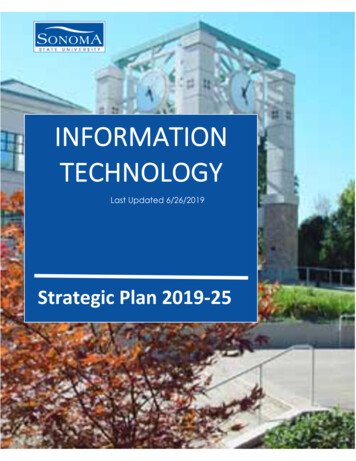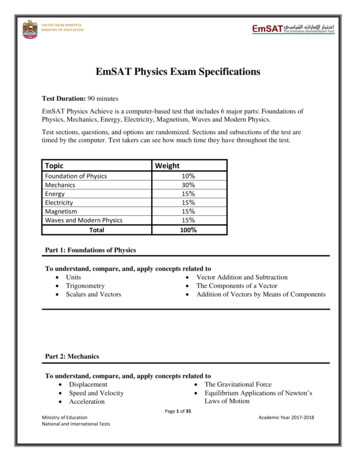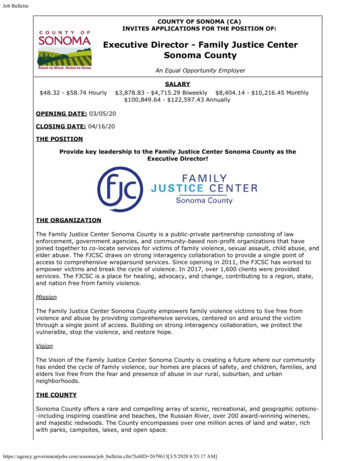
Transcription
ThePHYSICSMAJORSONOMA STATE UNIVERSITYDEPARTMENT OF PHYSICS AND ASTRONOMY2003school or the industrial sector. The Cerent laboratoriesare a huge step forward for Sonoma State University.”Physics courses in electronics, photonics, andmaterials are now being taught in the Cerent labs, andmany physics students are doing projects in them.Cerent Labs Make a DifferenceSonoma State University’s M.S. program inComputer & Engineering Science (CES), now in itssecond year, has had a huge impact on the Departmentof Physics and Astronomy. Founded by physicsprofessor Saeid Rahimi, now Dean of the School ofScience and Technology, the program raised asubstantial sum from companies and individuals,mostly in the local telecommunications industry.The result was the establishment of the CerentEngineering Sciences Complex in Salazar Hall, theformer library building.Besides several computer science laboratories, thecomplex includes four labs directed by members of theDepartment: the Rolf Ilsley Photonics Laboratory andAgilent Technologies Telecommunications Laboratory,both directed by Dr. Bryant Hichwa, the ElectronicsLaboratory, directed by Dr. Enrique Izaguirre, and theW.M. Keck Lab, codirected by Dr. Brock Weiss, andthe subject of its own article on p. 7.According to Dr. Hichwa,“The Cerent labs represent a unique and invaluableopportunity for the faculty and students of SSU. Thestudents and faculty now have the tools and systems todo cutting edge research in several areas of technology.These laboratories give our students a level ofexperience and expertise that students at other schoolscan only dream of. They allow our students to developthe self confidence to truly compete in the hightechnology job market into which they are thrust. Ourfaculty can give our students real problems, similar towhat they will encounter as they enter either graduateRamirez Honored asDistinguished AlumnusRoberto Ramirez, (’72) was one of four recipientsof the 2002 Distinguished Alumni Award from theSSU Alumni Association. He is the second physicsgraduate to be so honored, the first being RichardDefreez (’80), who was selected in 1995.Ramirez, who has taught mathematics and physicsfor many years at Healdsburg and Windsor HighSchools, has been called “the perfect role model.” Anative of Mexico who came to California at age 16, hewas still perfecting his English when he transferredfrom Santa Rosa Jr. College to what was then SonomaState College. He remembers being helped byprofessors Duncan Poland, Garrison Sposito, and SamGreene. By the time his degree was awarded in January1972 he had already started graduate school at UCLA,where he earned his teaching credential.The mentor of many students who have been thefirst in their families to go on to earn college degrees,Ramirez has also been honored with the 2002 CarlstonFamily Foundation Teacher of the Year Award, 1994California Human Development Corporation’s Outstanding Individual Award, and the Hispanic Chamberof Commerce of Sonoma County Award forDistinguished Community Service and ExemplaryLeadership in the Hispanic Community.
2honor of being awarded the Newkirk Assistantship andto Nadenia Newkirk for endowing it. It has been reallyexciting work and a wonderful learning experience forme.SSU Students Selected forSummer Research ProjectsNewkirk Assistantship donor Nadenia Newkirkand 2003 recipient Jerilynn SchisserFrom Australia to Mars?Elemental Analysis andthe Newkirk AssistantshipJerilynn SchisserFor the spring semester of 2003 I was awarded theHorace L. Newkirk Assistantship and worked with Dr.John Dunning to analyze lake bottom sand samplesfrom southwestern Australia. The analysis of thesesamples is part of research being conducted by Dr.Kathy Benison, a sedimentologist in the Department ofGeology at Central Michigan University. The samplesare from Australian acid saline lake environmentswhere the lakes and ground waters are unusually acidic,having a pH of 2.4 to 3.0. The mineral precipitatesfrom these lake bottoms may be quite similar to thechemical composition of the Martian surface. We hopethat our analyses will be used to help make up a catalogof “known” spectra from terrestrial samples to whichthe Martian data can be compared.Here at SSU, Dr. Dunning and I prepared thesamples and used X-Ray Diffraction (XRD) and theScanning Electron Microscope (SEM) to analyze thesand and minerals for elements. The XRD easilyidentified major peaks, and for some samples itidentified all elements present. Other samples were abit more complicated and required having the SEMconfirm or deny the possible elements as identified byXRD. In the process I got to increase my skills atmaterial analysis using XRD and I got to learn how tooperate the SEM, using it for both imaging andelemental analysis.Another collaborator is Dr. Darby Dyer, a geologistat Mount Holyoke College who specializes in using theMossbauer spectrometer. One of these spectrometerswill be carried to Mars on the next lander. Dr. Dyerand Dr. Benison will be presenting preliminary data atthe Lunar and Planetary Science Conference inHouston this spring. Eventually they may publish apaper on the spectral data of these saline acidenvironments, and possibly another paper, dependingon the data from Mars. Dr. Dunning would be listed asa co-author on these papers when published, and myname may appear as well. Wow! Thanks to the facultyof the Department of Physics and Astronomy for theDuring the summer of 2002 Tiffany Borders heldan intern position at the Space Telescope ScienceInstitute in Baltimore. She worked with the HubbleHeritage team and was in charge of processing imagesfrom the Hubble Space Telescope as part of theHubble Heritage Project. Tiffany was responsible forthe September 2002 release of Hoag’s Object, theOctober release of NGC 4319, and the Novemberrelease of NGC 6369. The Hubble Heritage Projectdelivers HST images to the public once a month athttp://heritage.stsci.edu. Tiffany states, “Among thebenefits from this internship was the opportunity tolearn about the many processes of HST image analysisand reduction as well as the experience of contributingto a team collaboration.” Tiffany will speak in the Mt.Tamalpais lecture series (http://www.mttam.net/astronomy.html) on Sept. 27 about her experienceswith the Hubble images.This summer Tiffany will be working for theNational Radio Astronomy Observatory in Socorro,New Mexico. She will work with Debra Shepherd andMark Claussen on “VLBA Water Maser Observationsof the Early B Protostar G192.16.” Tiffany is veryexcited about this opportunity to work in the field ofradio astronomy on a very intriguing research project.Last summer Ashley Wiren participated in aresearch experience for undergraduates program ininfrared astronomy at the University of Minnesota. Sheworked on projects such as photometry of M33 andpreparation for the soon-to-be-launched Space InfraredTelescope Facility (SIRTF).Next summer Ashley will go to the University ofDelaware to do research in physical ocean science andengineering. There she will work with the acousticDoppler current profilers aboard the U.S. Coast Guardship Healy.The Physics MajorNo. 28 May 2003Published byDepartment of Physics and AstronomySonoma State UniversityRohnert Park, CA 94928-3609(707) onoma.eduEdited by Joe TennWritten by Tiffany Borders, Michelle Curtis,Enrique Izaguirre, Bryant Hichwa, Logan Hill,Jerilynn Schisser, Gordon Spear, TyanaStiegler, Joe Tenn, Brock Weiss, and AshleyWiren.
3Biophysics and NeurobiologyEnrique IzaguirrePhysics is one of the most fascinating trips thathumankind can take, and the drive to understand cancause physicists to become tireless workers. Physics isconstantly overlapping many fields. Biomolecularelectronics and biophysics have recently undergone arevolution which has driven physics into new lands ofdiscovery. The undergraduate level has become achallenge for instructors and researchers who trainfuture scientists in this multidiscipline field of study.Here at Sonoma State, I am interested incontributing to this great educational effort from theresearch and pedagogical points of view. Since myarrival at SSU two years ago, I have been especiallydedicated to strengthening our curricula so as to helpblend the disciplines of physics and biology. I amdeveloping new courses in this combined field that willhelp prepare students to study biophysics and itsapplications. I am currently teaching a new course inneurobiology and neural networks, and in the fall I willintroduce a molecular biophysics course.It has been a rewarding experience to teachneurobiology and neural networks to the physics,biology and psychology students. I am impressed withthe positive reaction the students have to working inmultidisciplinary groups. The biology and psychologystudents benefit from the mathematical and analyticalskills of physicists, and physics students benefit fromthe laboratory skills and vocabulary of the biology andpsychology students.It was a real challenge to work with all of themdoing neural recording in worms and horseshoe crabs.During the course we also explored advancedtechniques of confocal and fluorescent microscopy bystaining the neurons of C. elegans worms, and weused a scanning electron microscope to visualize theomatides of an invertebrate compound eye.Students matched their experimental observationswith numerical data using numerical simulationspackages. I can say with satisfaction that this coursehas been an incredible experience for me and mystudents, experience that we will add to next term withthe new course in biophysics. In the next course wewill explore the molecules of life and the molecularprocesses. We will study the basic principles of cellbiology, molecular motors, protein dynamics and otherbiomolecules; our students will become familiar withappropriate equations and will understand the basics ofmolecular biology and the physical phenomenainvolved in life.In addition several students are doing research intopics closely related to the material learned in theclassroom. I am especially interested in proteinresearch with applications to biophotonics devices andbiomolecular electronics.As an example, lipid films doped with dyes andproteins are significant because they have the ability toself assemble and their electrical and biocompatibleproperties make them the most prominent candidates tointerface electronics and optics with living organisms.Students Farzaneh Rasti, Tedman Torres, and MarkLoguillo are currently working intensely on the use ofsurface plasmon resonance in organic films withbiomolecules, and on organic films and synthetictubular membranes with applications in optical devices.I strongly believe that our department with itsdynamics and strengths and exceptional student bodymakes Sonoma State University one of the best placesto start a strong career in physics.Dept. Hosts Physics TeachersOn April 4-5, 2003, the SSU Department ofPhysics and Astronomy played host to the NorthernCalifornia/Nevada Section of the American Associationof Physics Teachers. Dr. Joe Tenn, currentlypresident-elect of the section, was the local host, and allof the Department’s faculty, most of its staff, andseveral students participated.The meeting began on Friday with workshops. PaulRobinson of San Mateo High School, Dean Baird ofRio Americano High School, Lonnie Grimes ofOakmont High School and Dan Burns of Los GatosHigh School gave new teachers teaching tips inelectricity & magnetism and waves, and Dick Cooperof Gettysburg College demonstrated ContemporaryLaboratory Experiences In Astronomy (CLEA).Meanwhile Dr. Tenn was hosting the chairs of thephysics and astronomy departments of the CaliforniaState University system in their annual meeting.That evening, after a small banquet on campus, Dr.Lynn Cominsky and the NASA Education and PublicOutreach Group provided refreshments, and thenDepartment Technician Steve Anderson put on aspectacular laser light show. The evening ended withobservations at the SSU Observatory led by Dr.Gordon Spear and students Gray Slater and TiffanyBorders.Saturday saw a full day of talks and demonstrationsrelated to physics teaching. After a welcome by DeanSaeid Rahimi and the popular “Show and Tell,” Dr.Cominsky gave the invited lecture on the physics ofnuclear weapons.More than 100 physics teachers were wowed by theCerent Lab Complex, where Steve Anderson,Professors John Dunning, Bryant Hichwa, EnriqueIzaguirre, and Brock Weiss, and students TimMcKernan and Tom Bittancourt demonstrated the newinstruments. An added attraction was cookies in thelabs, thanks to Sarah Silva (’02) and friends.
4E/PO Group MovesLogan HillFor the NASA Education and Public Outreach(E/PO) Group, the transition from Darwin to their newlocation, dubbed “the Fort,” is now finished. Situatedin the northwestern corner of campus, the fort was thesmallest of the three old Tech High School buildings.Professor Lynn Cominsky directs the group whichdevelops and refines tools for the teaching of NASAscience to the public. She has other NASA endeavorsas well, such as being a part of the GLAST and Swiftmission teams and working on the Federal AdvisoryCommittee that recommends policy to NASA.Manning the battlements is a host of employees.Tim Graves (’01) is the Instructional TechnologyConsultant, who forges the swords and shields of codeand interconnected hardware for the group, and NorthBay Science Project Site Director Sharon Janulaw isout drawing in elementary and high school teachers toimplement the E/PO group’s tools as well as otherteacher support utilities. Program Manager Phil Plait,with the “Bad Astronomer” standard held high, is theGroup’s emissary of pseudo-science debunking andpublic relations; Assistant Program Manager SarahSilva (’02) oversees the use of the group’s coffers; andAurore Simonnet designs the standards and heraldry ofvarious NASA projects as the Scientific Illustrator forthe group.The standing guard is composed of studentassistants who handle a variety of tasks: TiffanyBorders, knight of GLAST Telescope Network (GTN)support; Michelle Curtis, knight of Science Writingand Web Support; Logan Hill, knight of ScienceWriting, Gray Slater knight-captain of Group Supportand GTN, Schell Scivally, knight of ComputerAdministration, Ashley Wiren, knight of North BayScience Project and Web Support. In addition, Dr.Gordon Spear coordinates the GLAST TelescopeNetwork development [following article].The group is handling the public education for theUS portion of the XMM-Newton X-ray satellite;GLAST (Gamma-ray Large Area Space Telescope),expected to launch in 2006 to observe gamma-raysources in the energy range of 10 keV to 300 GeV; andthe Swift satellite, which will locate the sources ofgamma-ray bursts and is due to launch in late 2003.The group has developed several tools to helpeducate the public about these and other projects,ranging from Swift slinkies and logarithmic studyguides, to interactive web-based video games.SSU Has a New TelescopeGordon SpearA new robotic telescope system is available forstudent use. Purchased for the NASA E/PO programfor the Gamma-ray Large Area Space Telescope(GLAST), the new telescope system will support theGLAST mission and will be used to monitor blazars,other active galaxies, and cataclysmic variables.Dubbed RTS1, the system will provide opportunitiesfor K-12 students and their teachers as well as SSUstudents to participate in scientific research. Thesystem consists of a Celestron 14-inch telescope on aParamount telescope mount, the first commerciallyavailable telescope mount designed specifically forrobotic use.The system also includes an Apogee AP47 CCDcamera with integrated BVRI photometric filters. It iscurrently installed at the SSU Observatory (SSUO) forevaluation and software development, and can presentlypoint reliably to within 10 arcseconds on the sky. TheApogee CCD camera is estimated to be at least 6 timesmore sensitive than the SBIG ST7 camera that hasbeen in use at SSUO on the 10-inch Epoch telescopefor the past several years. It is estimated that the newsystem can achieve reliable photometry for 15thmagnitude objects with 2-minute exposures.The new system will soon move to the CaliforniaAcademy of Sciences’ Pepperwood Preserve north ofSanta Rosa. While this system will initially be runfrom a control room at the Preserve, the system willultimately be Internet-accessible for remote operation.The venerable C14 telescope used at SSUO sinceits founding in 1976 has been disassembled and is instorage. After RTS1 has been safely moved to its newhome, it is hoped that this old telescope will bereinstalled at SSUO, but with a new mount. Yes, we arecurrently seeking a donor for a new mount.Exterior lighting for the new residence halls adjacent to the stadium area where the SSU Observatory islocated will be turned on sometime this summer. Oncethat happens any research at SSUO will be limited tobright objects. However, the observatory should still beavailable to allow introductory astronomy students andthe public to view bright objects such as the moon andplanets. As strangely as such things often turn out,high speed Internet access for the Observatory will alsobecome available this summer. Thus, when we are nolonger able to see faint objects, we will have the abilityto rapidly send images to other locations.With light pollution now increased to unacceptablelevels, might it be possible to relocate the Observatoryto a dark site at some off-campus location? A fundraising proposal has been submitted to the Universityto establish such a facility. While the Universityadministration is generally supportive, the economymay not allow a rapid start for such a major fundraising project. We will continue to explore such anopportunity, but we will proceed slowly. Regardless ofthe short-term situation, research in observationalastronomy will certainly continue at SSU and studentswill still have opportunities to participate in excitingresearch programs in astronomy.
5Teaching to Demystify PhysicsFarewell to SSUMichelle CurtisAfter many years in industry, during which he oftentaught evening courses at SSU, Dr. Bryant Hichwajoined the regular faculty last fall. This spring he wasone of a handful of professors nominated for SSU’sExcellence in Teaching Award.I sat down with Dr. Hichwa to discuss his first yearas a faculty member in the Department of Physics andAstronomy. What came across in the conversation washis enjoyment of being a teacher and how happy thelast year of teaching has made him. The enjoyment andsatisfaction he has experienced stems from hisinteraction with students, being able to share hisknowledge of physics as well as of industry andbusiness, and especially seeing his students succeed.Dr. Hichwa incorporates into his teaching his owneducational experiences and his work in industry.Underlying his teaching philosophy is the notion of“learn how to do it.” The significance of students tolearn not only what a text-book offers, but the skillsthat they will carry with them throughout theiracademic and professional careers, is incorporated intohis approach in the classroom. No matter what he hasdone professionally he has always found himselfenjoying teaching, whether in business throughmentoring or in classroom instruction. Helpingstudents understand is truly important to him.One student summed up his experiences by noting,Dr. Hichwa “ doesn’t decide what his students arecapable of, he lets the students decide for themselves.”Another commented on how rewarding being in Dr.Hichwa’s classes has been, noting “there is lesspressure to perform, more importance placed onlearning.” Another student remarked that interestingfeatures of his lectures are the interjections about how atopic that is being discussed has been approached inindustry and how the details of a particular technologyare used.I asked Dr. Hichwa what experiences he has had inhis own academic
opportunity for the faculty and students of SSU. The where he earned his teaching credential. students and faculty now have the tools and systems to The mentor of many students who have been the do cutting edge research in several areas of technology. first in their families to











